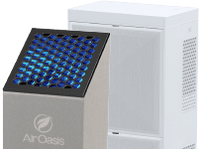Natural & Green Air Purifiers
Humans need air to survive. Many people think that what they breathe outside does more harm than what they have lingering around in their homes. On the contrary, the concentration of indoor air pollutants ranges from two to five times higher than tests reveal for outdoor air. This swells to more than one hundred times that of outdoor levels during the winter months. In the United States, people spend 90 percent of their time indoors doing activities such as working at an office desk for eight hours a day or shopping at the local mall for a couple of hours. Needless to say, the amount of time spent indoors exposes people to more toxins than their bodies can handle. Exposure to indoor pollutants can lead to a wide variety of physical ailments, including coughing, sneezing, dizziness, fatigue, and eye irritation. Prolonged exposure can lead to the development of chronic diseases, such as heart disease, respiratory illness, and even cancer.
Internal sources of poor indoor air quality (IAQ) fall into three categories, including particulate matter, microbes, and gases. Humans cannot see the majority of these contaminants with the naked eye, which means they can easily infiltrate the lungs. Microbes include organisms such as bacteria, viruses, protozoa, fungi, and mold. The majority of microbial organisms rely on humid and moist environments to survive. Some produce harmful chemicals, such as mycotoxins and volatile organic compounds (VOCs), which can lead to adverse health effects in humans. Indoor air pollution also consists of gases and odors, such as formaldehyde, benzene, carbon monoxide, carbon dioxide, and hydrogen sulfide. Gases and odors are released into the air from ordinary household products and items, such as furniture, aerosol hygiene products, cleaning products, insulation, and pesticides. Gases and odors largely consist of volatile organic compounds (VOCs), which become airborne.
Many health-conscious people have sought a viable solution to effectively clean their air. Some have decided to purchase a natural air purifier that does not produce hazardous gaseous byproducts and leaves less of a footprint on the environment. Many air ionizers produce a gaseous byproduct called ozone in low amounts. A high concentration of ozone can prove dangerous if left unchecked. A green air purifier, however, can keep ozone from becoming a hazard. A natural air purifier should also consume low energy and require little to no filter replacement. Search no further for your green air purifier needs than Air Oasis.
Air Oasis offers a line of safe air purifiers that eliminates indoor air pollutants while also sanitizing surfaces. Our Air Sanifiers® have been proven to increase indoor air quality in residential and commercial buildings. According to Dr. Nabarun Ghosh at West Texas A&M University, our natural air sanitizer products effectively reduce biological contaminants to safe levels. One case study reported an 82.7% bacterial reduction count over the course of three hours using the nano Induct air purifier. It also reduced the total volatile organic compounds by more than 99 percent. In another case study, the LAWN Environmental Protection analysis of indoor air quality of buses revealed a 22 percent reduction in bacterial contaminants after using our air purifiers.
Our customers can gain confidence knowing that they have chosen the best air purifiers on the market. Our air purifiers utilize a combination of five technologies, including True H13 HEPA filtration, UV-C light, silver ions, activated carbon, and Bi-Polar® Ionization. This natural air purification system makes our products superior in quality when compared to other units. If you own a home with multiple rooms, we suggest placing several units throughout the house to obtain optimum indoor air quality.
